Running Home: Social Enterprise Services and Funding Analysis
VerifiedAdded on 2021/04/21
|20
|4592
|81
Report
AI Summary
This report examines Running Home, a social enterprise in the UK dedicated to elderly care. It explores the organization's aims, objectives, management structure, market needs, services, target community, delivery strategy, partnership working, organizational culture, policies, procedures, sources of funding, and monitoring and evaluation. The report analyzes the context of healthcare and social enterprise in the UK, focusing on the financial aspects and exploring funding strategies such as Money Follows The Patient, microfinancing, commissioning of services, and state government subsidies. The report also discusses the management structure, services provided, and the target community of Running Home, providing insights into how the enterprise aims to deliver affordable and intensive care to the elderly population. This report provides a comprehensive analysis of the social enterprise model in the context of elderly care.
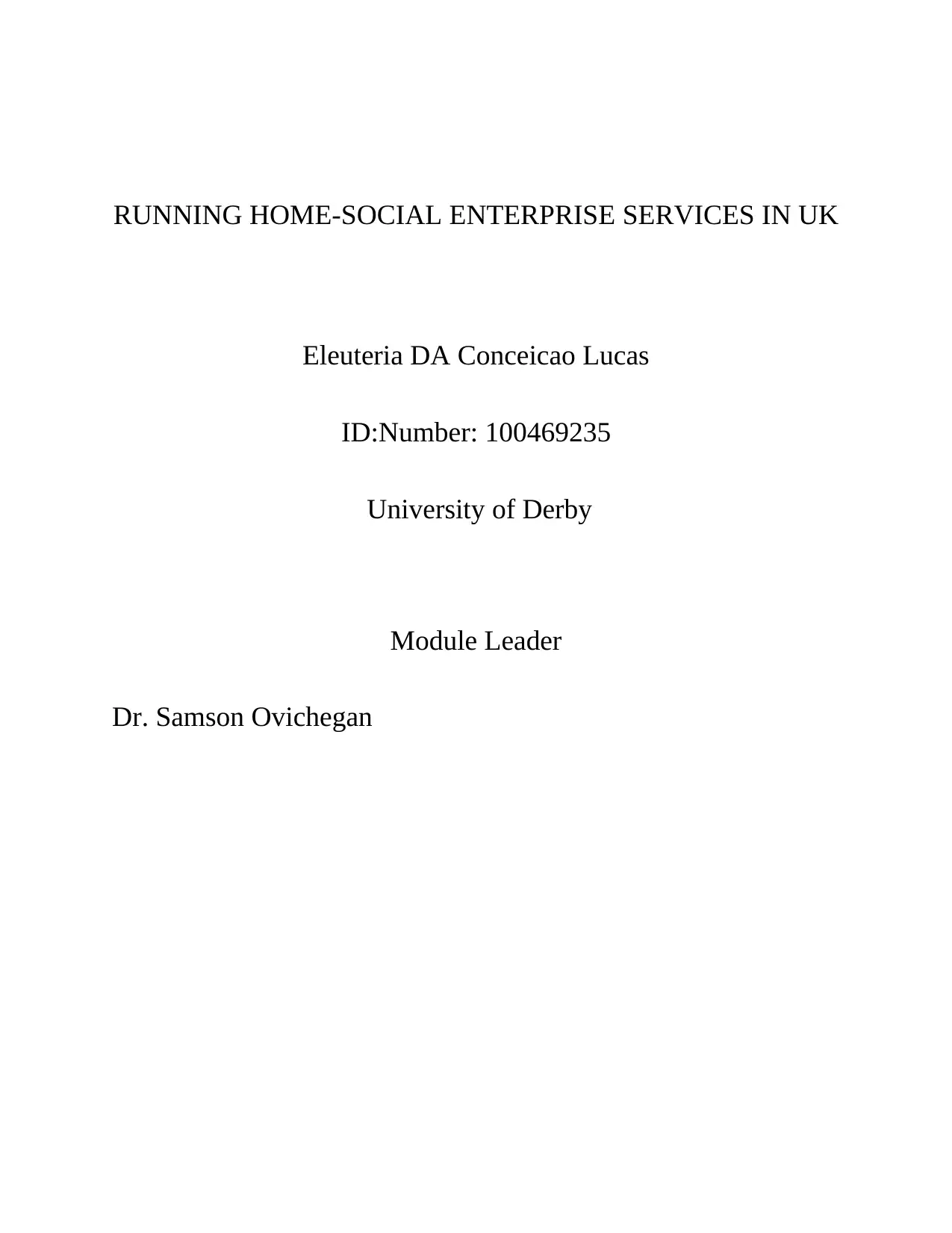
RUNNING HOME-SOCIAL ENTERPRISE SERVICES IN UK
Eleuteria DA Conceicao Lucas
ID:Number: 100469235
University of Derby
Module Leader
Dr. Samson Ovichegan
Eleuteria DA Conceicao Lucas
ID:Number: 100469235
University of Derby
Module Leader
Dr. Samson Ovichegan
Paraphrase This Document
Need a fresh take? Get an instant paraphrase of this document with our AI Paraphraser
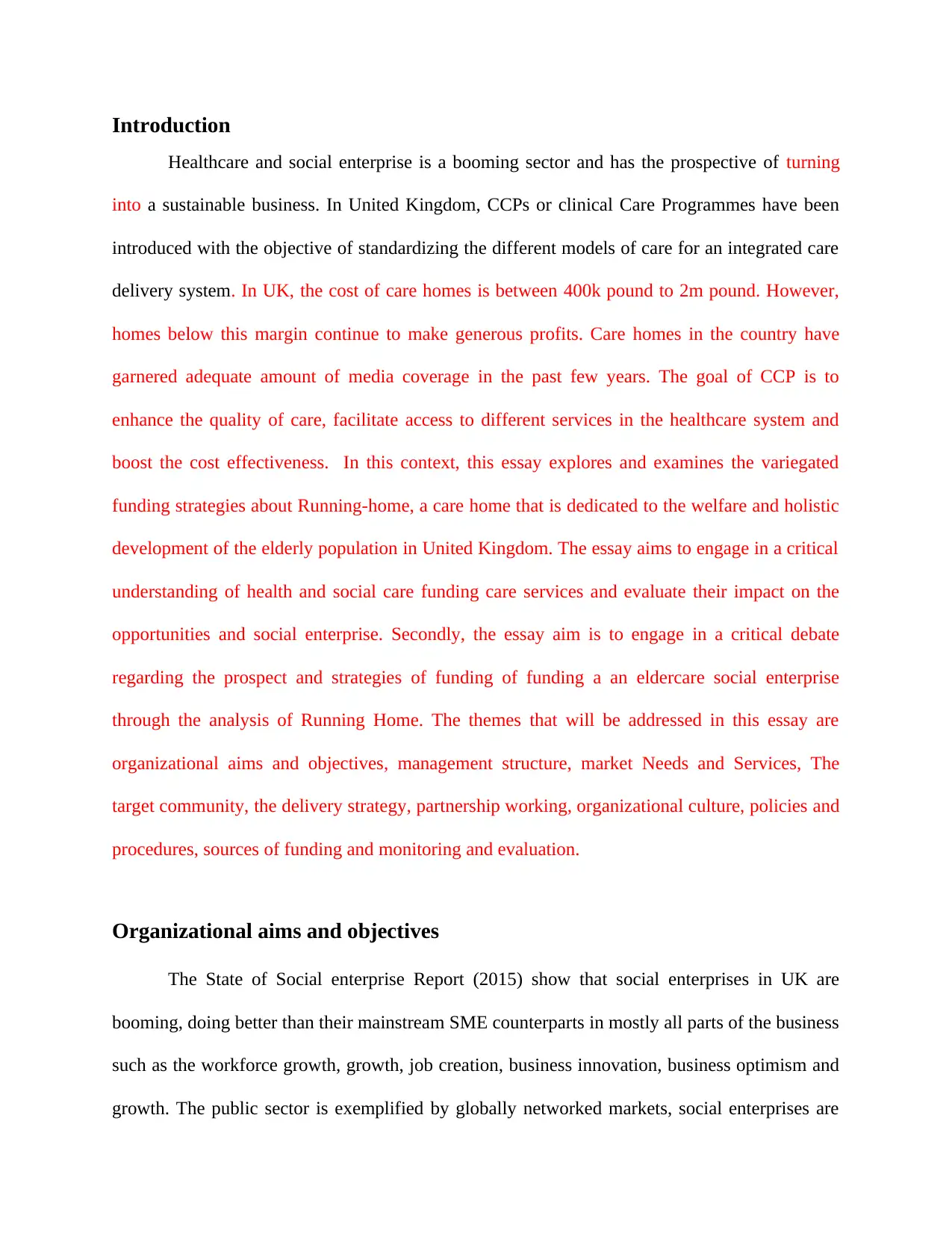
Introduction
Healthcare and social enterprise is a booming sector and has the prospective of turning
into a sustainable business. In United Kingdom, CCPs or clinical Care Programmes have been
introduced with the objective of standardizing the different models of care for an integrated care
delivery system. In UK, the cost of care homes is between 400k pound to 2m pound. However,
homes below this margin continue to make generous profits. Care homes in the country have
garnered adequate amount of media coverage in the past few years. The goal of CCP is to
enhance the quality of care, facilitate access to different services in the healthcare system and
boost the cost effectiveness. In this context, this essay explores and examines the variegated
funding strategies about Running-home, a care home that is dedicated to the welfare and holistic
development of the elderly population in United Kingdom. The essay aims to engage in a critical
understanding of health and social care funding care services and evaluate their impact on the
opportunities and social enterprise. Secondly, the essay aim is to engage in a critical debate
regarding the prospect and strategies of funding of funding a an eldercare social enterprise
through the analysis of Running Home. The themes that will be addressed in this essay are
organizational aims and objectives, management structure, market Needs and Services, The
target community, the delivery strategy, partnership working, organizational culture, policies and
procedures, sources of funding and monitoring and evaluation.
Organizational aims and objectives
The State of Social enterprise Report (2015) show that social enterprises in UK are
booming, doing better than their mainstream SME counterparts in mostly all parts of the business
such as the workforce growth, growth, job creation, business innovation, business optimism and
growth. The public sector is exemplified by globally networked markets, social enterprises are
Healthcare and social enterprise is a booming sector and has the prospective of turning
into a sustainable business. In United Kingdom, CCPs or clinical Care Programmes have been
introduced with the objective of standardizing the different models of care for an integrated care
delivery system. In UK, the cost of care homes is between 400k pound to 2m pound. However,
homes below this margin continue to make generous profits. Care homes in the country have
garnered adequate amount of media coverage in the past few years. The goal of CCP is to
enhance the quality of care, facilitate access to different services in the healthcare system and
boost the cost effectiveness. In this context, this essay explores and examines the variegated
funding strategies about Running-home, a care home that is dedicated to the welfare and holistic
development of the elderly population in United Kingdom. The essay aims to engage in a critical
understanding of health and social care funding care services and evaluate their impact on the
opportunities and social enterprise. Secondly, the essay aim is to engage in a critical debate
regarding the prospect and strategies of funding of funding a an eldercare social enterprise
through the analysis of Running Home. The themes that will be addressed in this essay are
organizational aims and objectives, management structure, market Needs and Services, The
target community, the delivery strategy, partnership working, organizational culture, policies and
procedures, sources of funding and monitoring and evaluation.
Organizational aims and objectives
The State of Social enterprise Report (2015) show that social enterprises in UK are
booming, doing better than their mainstream SME counterparts in mostly all parts of the business
such as the workforce growth, growth, job creation, business innovation, business optimism and
growth. The public sector is exemplified by globally networked markets, social enterprises are
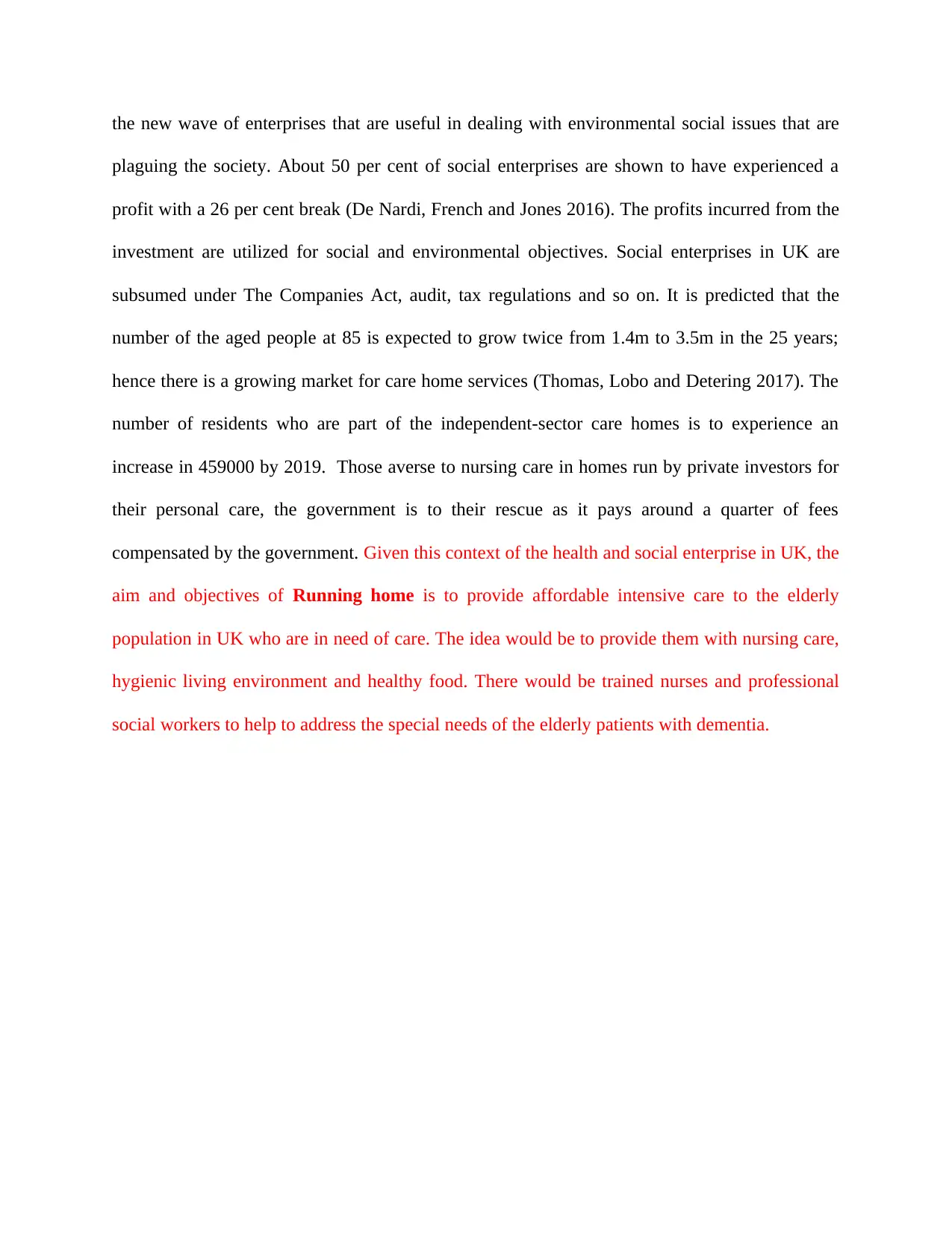
the new wave of enterprises that are useful in dealing with environmental social issues that are
plaguing the society. About 50 per cent of social enterprises are shown to have experienced a
profit with a 26 per cent break (De Nardi, French and Jones 2016). The profits incurred from the
investment are utilized for social and environmental objectives. Social enterprises in UK are
subsumed under The Companies Act, audit, tax regulations and so on. It is predicted that the
number of the aged people at 85 is expected to grow twice from 1.4m to 3.5m in the 25 years;
hence there is a growing market for care home services (Thomas, Lobo and Detering 2017). The
number of residents who are part of the independent-sector care homes is to experience an
increase in 459000 by 2019. Those averse to nursing care in homes run by private investors for
their personal care, the government is to their rescue as it pays around a quarter of fees
compensated by the government. Given this context of the health and social enterprise in UK, the
aim and objectives of Running home is to provide affordable intensive care to the elderly
population in UK who are in need of care. The idea would be to provide them with nursing care,
hygienic living environment and healthy food. There would be trained nurses and professional
social workers to help to address the special needs of the elderly patients with dementia.
plaguing the society. About 50 per cent of social enterprises are shown to have experienced a
profit with a 26 per cent break (De Nardi, French and Jones 2016). The profits incurred from the
investment are utilized for social and environmental objectives. Social enterprises in UK are
subsumed under The Companies Act, audit, tax regulations and so on. It is predicted that the
number of the aged people at 85 is expected to grow twice from 1.4m to 3.5m in the 25 years;
hence there is a growing market for care home services (Thomas, Lobo and Detering 2017). The
number of residents who are part of the independent-sector care homes is to experience an
increase in 459000 by 2019. Those averse to nursing care in homes run by private investors for
their personal care, the government is to their rescue as it pays around a quarter of fees
compensated by the government. Given this context of the health and social enterprise in UK, the
aim and objectives of Running home is to provide affordable intensive care to the elderly
population in UK who are in need of care. The idea would be to provide them with nursing care,
hygienic living environment and healthy food. There would be trained nurses and professional
social workers to help to address the special needs of the elderly patients with dementia.
⊘ This is a preview!⊘
Do you want full access?
Subscribe today to unlock all pages.

Trusted by 1+ million students worldwide
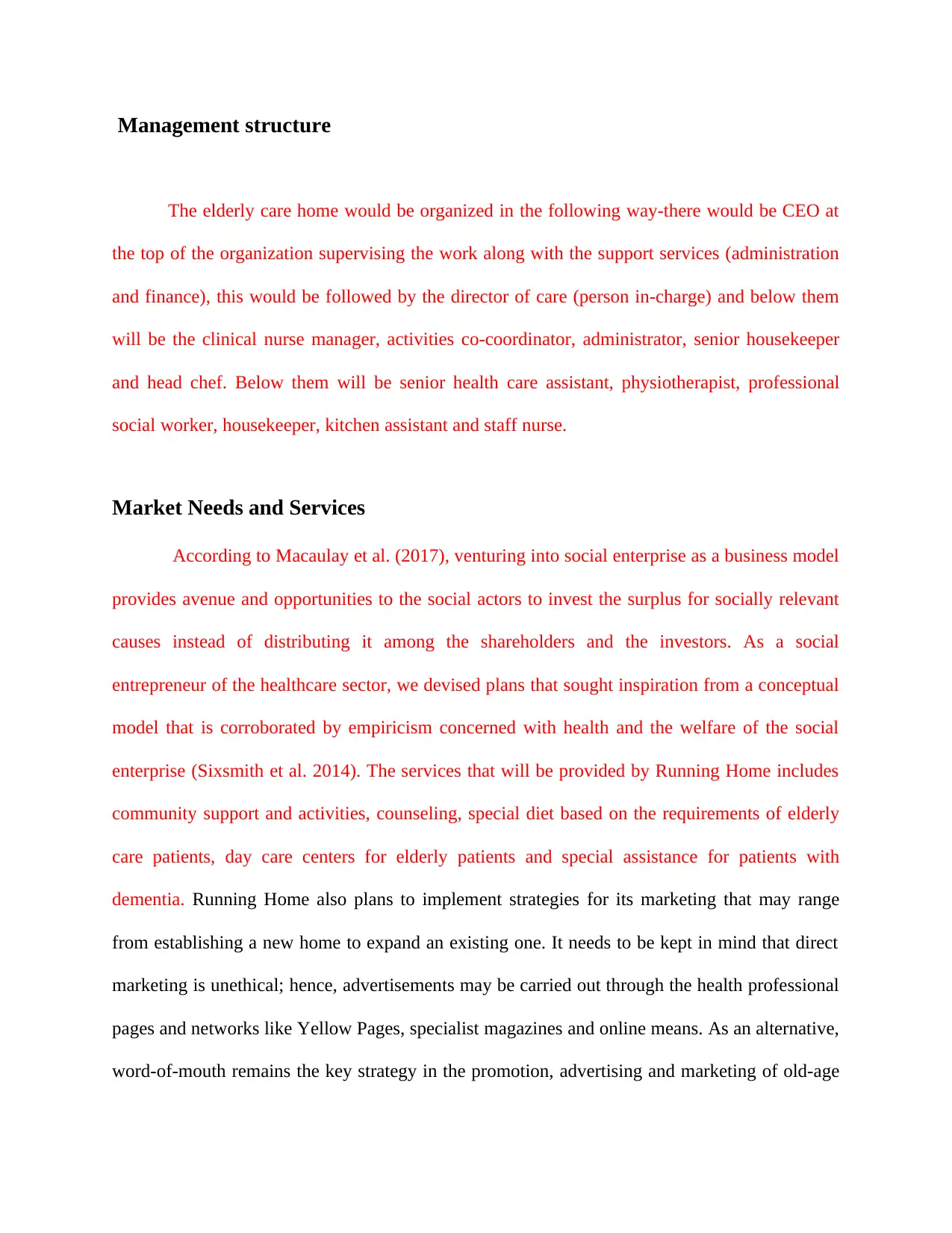
Management structure
The elderly care home would be organized in the following way-there would be CEO at
the top of the organization supervising the work along with the support services (administration
and finance), this would be followed by the director of care (person in-charge) and below them
will be the clinical nurse manager, activities co-coordinator, administrator, senior housekeeper
and head chef. Below them will be senior health care assistant, physiotherapist, professional
social worker, housekeeper, kitchen assistant and staff nurse.
Market Needs and Services
According to Macaulay et al. (2017), venturing into social enterprise as a business model
provides avenue and opportunities to the social actors to invest the surplus for socially relevant
causes instead of distributing it among the shareholders and the investors. As a social
entrepreneur of the healthcare sector, we devised plans that sought inspiration from a conceptual
model that is corroborated by empiricism concerned with health and the welfare of the social
enterprise (Sixsmith et al. 2014). The services that will be provided by Running Home includes
community support and activities, counseling, special diet based on the requirements of elderly
care patients, day care centers for elderly patients and special assistance for patients with
dementia. Running Home also plans to implement strategies for its marketing that may range
from establishing a new home to expand an existing one. It needs to be kept in mind that direct
marketing is unethical; hence, advertisements may be carried out through the health professional
pages and networks like Yellow Pages, specialist magazines and online means. As an alternative,
word-of-mouth remains the key strategy in the promotion, advertising and marketing of old-age
The elderly care home would be organized in the following way-there would be CEO at
the top of the organization supervising the work along with the support services (administration
and finance), this would be followed by the director of care (person in-charge) and below them
will be the clinical nurse manager, activities co-coordinator, administrator, senior housekeeper
and head chef. Below them will be senior health care assistant, physiotherapist, professional
social worker, housekeeper, kitchen assistant and staff nurse.
Market Needs and Services
According to Macaulay et al. (2017), venturing into social enterprise as a business model
provides avenue and opportunities to the social actors to invest the surplus for socially relevant
causes instead of distributing it among the shareholders and the investors. As a social
entrepreneur of the healthcare sector, we devised plans that sought inspiration from a conceptual
model that is corroborated by empiricism concerned with health and the welfare of the social
enterprise (Sixsmith et al. 2014). The services that will be provided by Running Home includes
community support and activities, counseling, special diet based on the requirements of elderly
care patients, day care centers for elderly patients and special assistance for patients with
dementia. Running Home also plans to implement strategies for its marketing that may range
from establishing a new home to expand an existing one. It needs to be kept in mind that direct
marketing is unethical; hence, advertisements may be carried out through the health professional
pages and networks like Yellow Pages, specialist magazines and online means. As an alternative,
word-of-mouth remains the key strategy in the promotion, advertising and marketing of old-age
Paraphrase This Document
Need a fresh take? Get an instant paraphrase of this document with our AI Paraphraser
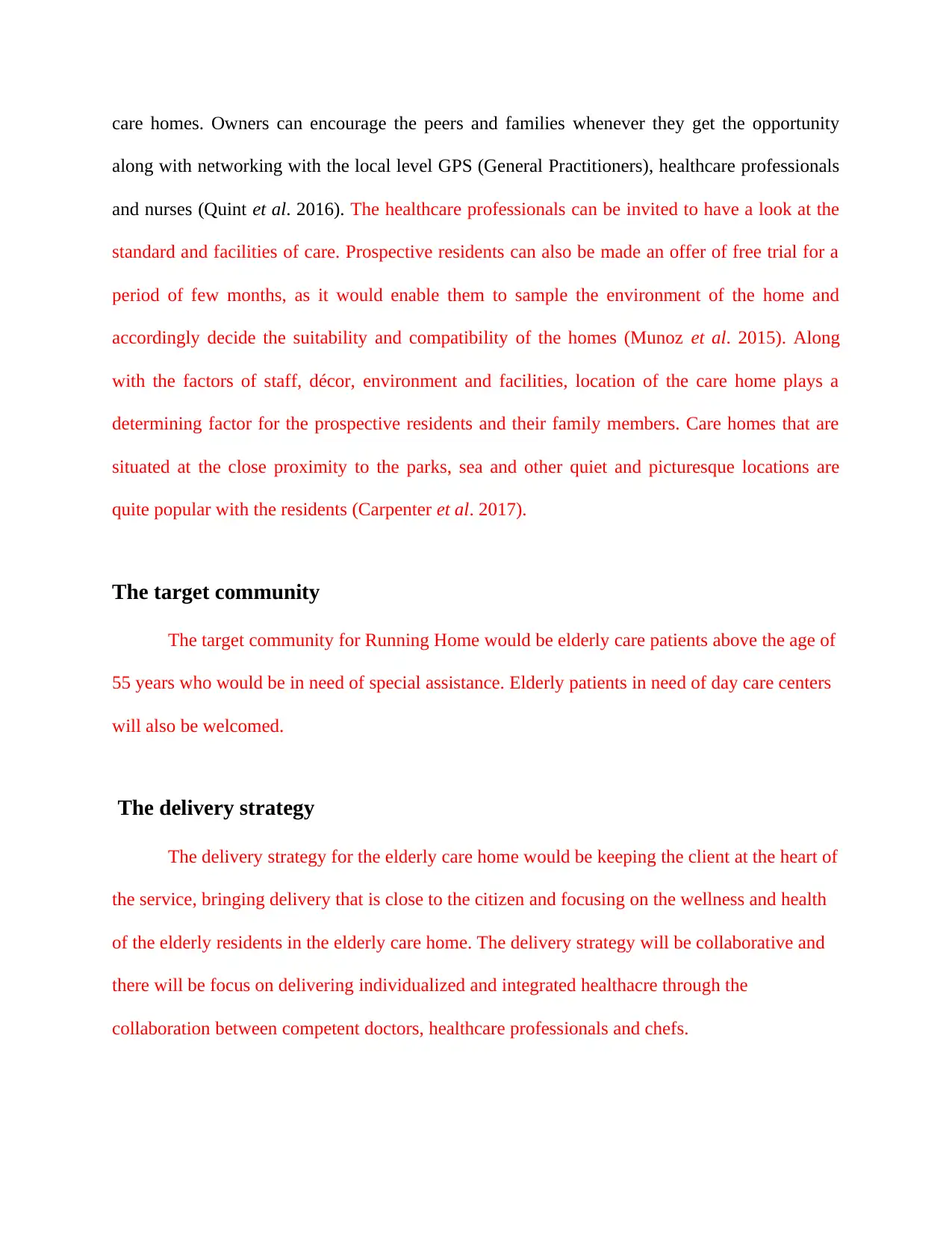
care homes. Owners can encourage the peers and families whenever they get the opportunity
along with networking with the local level GPS (General Practitioners), healthcare professionals
and nurses (Quint et al. 2016). The healthcare professionals can be invited to have a look at the
standard and facilities of care. Prospective residents can also be made an offer of free trial for a
period of few months, as it would enable them to sample the environment of the home and
accordingly decide the suitability and compatibility of the homes (Munoz et al. 2015). Along
with the factors of staff, décor, environment and facilities, location of the care home plays a
determining factor for the prospective residents and their family members. Care homes that are
situated at the close proximity to the parks, sea and other quiet and picturesque locations are
quite popular with the residents (Carpenter et al. 2017).
The target community
The target community for Running Home would be elderly care patients above the age of
55 years who would be in need of special assistance. Elderly patients in need of day care centers
will also be welcomed.
The delivery strategy
The delivery strategy for the elderly care home would be keeping the client at the heart of
the service, bringing delivery that is close to the citizen and focusing on the wellness and health
of the elderly residents in the elderly care home. The delivery strategy will be collaborative and
there will be focus on delivering individualized and integrated healthacre through the
collaboration between competent doctors, healthcare professionals and chefs.
along with networking with the local level GPS (General Practitioners), healthcare professionals
and nurses (Quint et al. 2016). The healthcare professionals can be invited to have a look at the
standard and facilities of care. Prospective residents can also be made an offer of free trial for a
period of few months, as it would enable them to sample the environment of the home and
accordingly decide the suitability and compatibility of the homes (Munoz et al. 2015). Along
with the factors of staff, décor, environment and facilities, location of the care home plays a
determining factor for the prospective residents and their family members. Care homes that are
situated at the close proximity to the parks, sea and other quiet and picturesque locations are
quite popular with the residents (Carpenter et al. 2017).
The target community
The target community for Running Home would be elderly care patients above the age of
55 years who would be in need of special assistance. Elderly patients in need of day care centers
will also be welcomed.
The delivery strategy
The delivery strategy for the elderly care home would be keeping the client at the heart of
the service, bringing delivery that is close to the citizen and focusing on the wellness and health
of the elderly residents in the elderly care home. The delivery strategy will be collaborative and
there will be focus on delivering individualized and integrated healthacre through the
collaboration between competent doctors, healthcare professionals and chefs.
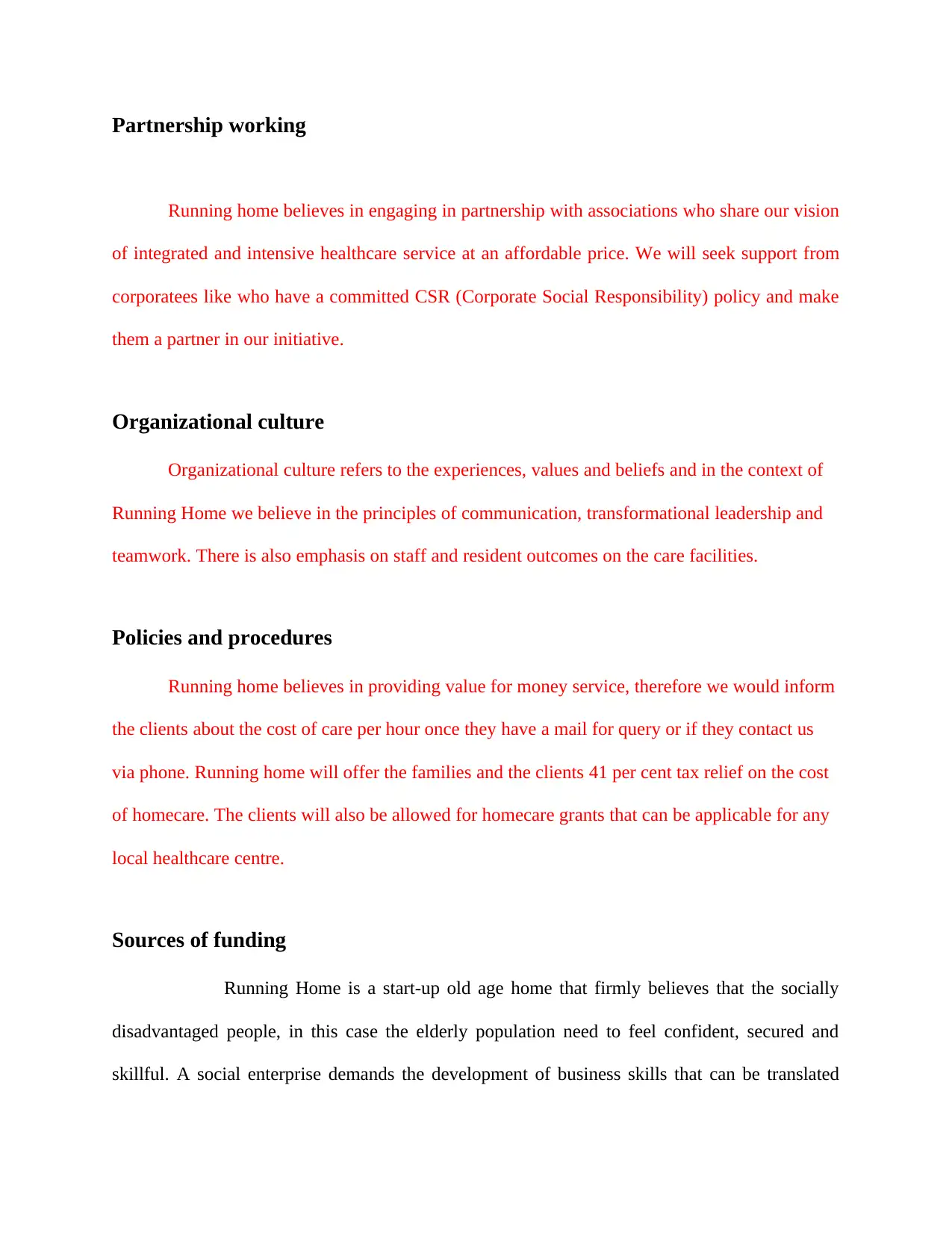
Partnership working
Running home believes in engaging in partnership with associations who share our vision
of integrated and intensive healthcare service at an affordable price. We will seek support from
corporatees like who have a committed CSR (Corporate Social Responsibility) policy and make
them a partner in our initiative.
Organizational culture
Organizational culture refers to the experiences, values and beliefs and in the context of
Running Home we believe in the principles of communication, transformational leadership and
teamwork. There is also emphasis on staff and resident outcomes on the care facilities.
Policies and procedures
Running home believes in providing value for money service, therefore we would inform
the clients about the cost of care per hour once they have a mail for query or if they contact us
via phone. Running home will offer the families and the clients 41 per cent tax relief on the cost
of homecare. The clients will also be allowed for homecare grants that can be applicable for any
local healthcare centre.
Sources of funding
Running Home is a start-up old age home that firmly believes that the socially
disadvantaged people, in this case the elderly population need to feel confident, secured and
skillful. A social enterprise demands the development of business skills that can be translated
Running home believes in engaging in partnership with associations who share our vision
of integrated and intensive healthcare service at an affordable price. We will seek support from
corporatees like who have a committed CSR (Corporate Social Responsibility) policy and make
them a partner in our initiative.
Organizational culture
Organizational culture refers to the experiences, values and beliefs and in the context of
Running Home we believe in the principles of communication, transformational leadership and
teamwork. There is also emphasis on staff and resident outcomes on the care facilities.
Policies and procedures
Running home believes in providing value for money service, therefore we would inform
the clients about the cost of care per hour once they have a mail for query or if they contact us
via phone. Running home will offer the families and the clients 41 per cent tax relief on the cost
of homecare. The clients will also be allowed for homecare grants that can be applicable for any
local healthcare centre.
Sources of funding
Running Home is a start-up old age home that firmly believes that the socially
disadvantaged people, in this case the elderly population need to feel confident, secured and
skillful. A social enterprise demands the development of business skills that can be translated
⊘ This is a preview!⊘
Do you want full access?
Subscribe today to unlock all pages.

Trusted by 1+ million students worldwide
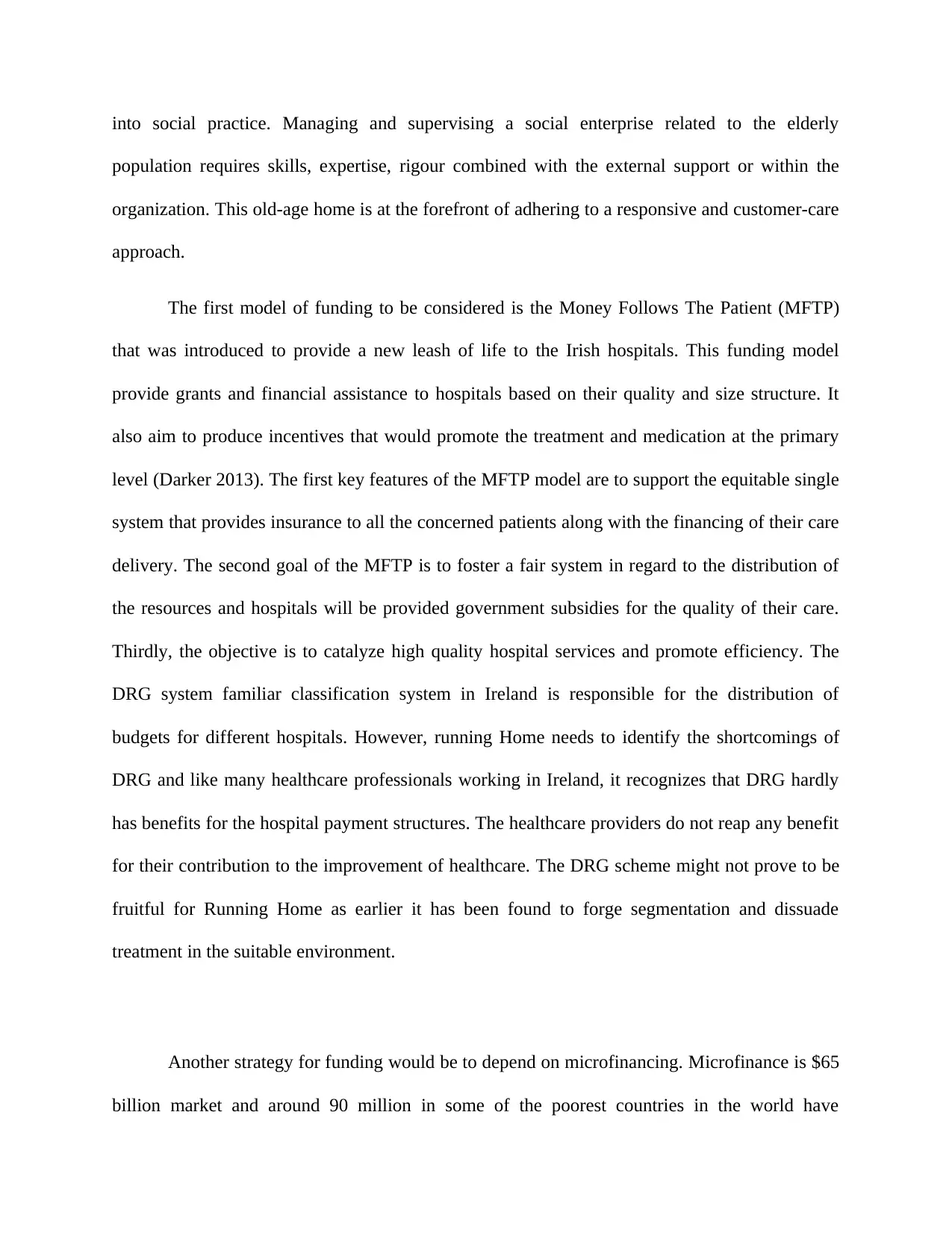
into social practice. Managing and supervising a social enterprise related to the elderly
population requires skills, expertise, rigour combined with the external support or within the
organization. This old-age home is at the forefront of adhering to a responsive and customer-care
approach.
The first model of funding to be considered is the Money Follows The Patient (MFTP)
that was introduced to provide a new leash of life to the Irish hospitals. This funding model
provide grants and financial assistance to hospitals based on their quality and size structure. It
also aim to produce incentives that would promote the treatment and medication at the primary
level (Darker 2013). The first key features of the MFTP model are to support the equitable single
system that provides insurance to all the concerned patients along with the financing of their care
delivery. The second goal of the MFTP is to foster a fair system in regard to the distribution of
the resources and hospitals will be provided government subsidies for the quality of their care.
Thirdly, the objective is to catalyze high quality hospital services and promote efficiency. The
DRG system familiar classification system in Ireland is responsible for the distribution of
budgets for different hospitals. However, running Home needs to identify the shortcomings of
DRG and like many healthcare professionals working in Ireland, it recognizes that DRG hardly
has benefits for the hospital payment structures. The healthcare providers do not reap any benefit
for their contribution to the improvement of healthcare. The DRG scheme might not prove to be
fruitful for Running Home as earlier it has been found to forge segmentation and dissuade
treatment in the suitable environment.
Another strategy for funding would be to depend on microfinancing. Microfinance is $65
billion market and around 90 million in some of the poorest countries in the world have
population requires skills, expertise, rigour combined with the external support or within the
organization. This old-age home is at the forefront of adhering to a responsive and customer-care
approach.
The first model of funding to be considered is the Money Follows The Patient (MFTP)
that was introduced to provide a new leash of life to the Irish hospitals. This funding model
provide grants and financial assistance to hospitals based on their quality and size structure. It
also aim to produce incentives that would promote the treatment and medication at the primary
level (Darker 2013). The first key features of the MFTP model are to support the equitable single
system that provides insurance to all the concerned patients along with the financing of their care
delivery. The second goal of the MFTP is to foster a fair system in regard to the distribution of
the resources and hospitals will be provided government subsidies for the quality of their care.
Thirdly, the objective is to catalyze high quality hospital services and promote efficiency. The
DRG system familiar classification system in Ireland is responsible for the distribution of
budgets for different hospitals. However, running Home needs to identify the shortcomings of
DRG and like many healthcare professionals working in Ireland, it recognizes that DRG hardly
has benefits for the hospital payment structures. The healthcare providers do not reap any benefit
for their contribution to the improvement of healthcare. The DRG scheme might not prove to be
fruitful for Running Home as earlier it has been found to forge segmentation and dissuade
treatment in the suitable environment.
Another strategy for funding would be to depend on microfinancing. Microfinance is $65
billion market and around 90 million in some of the poorest countries in the world have
Paraphrase This Document
Need a fresh take? Get an instant paraphrase of this document with our AI Paraphraser
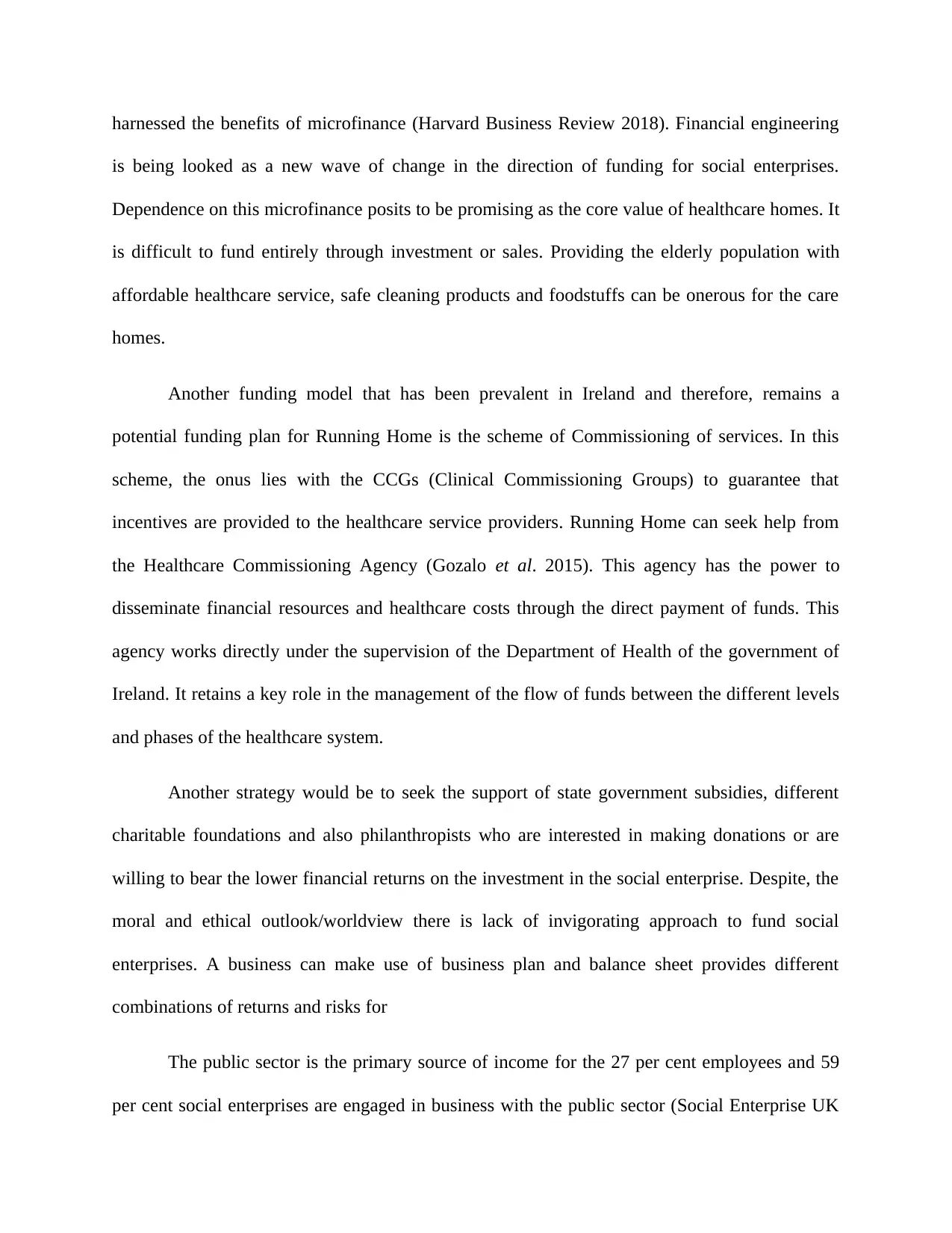
harnessed the benefits of microfinance (Harvard Business Review 2018). Financial engineering
is being looked as a new wave of change in the direction of funding for social enterprises.
Dependence on this microfinance posits to be promising as the core value of healthcare homes. It
is difficult to fund entirely through investment or sales. Providing the elderly population with
affordable healthcare service, safe cleaning products and foodstuffs can be onerous for the care
homes.
Another funding model that has been prevalent in Ireland and therefore, remains a
potential funding plan for Running Home is the scheme of Commissioning of services. In this
scheme, the onus lies with the CCGs (Clinical Commissioning Groups) to guarantee that
incentives are provided to the healthcare service providers. Running Home can seek help from
the Healthcare Commissioning Agency (Gozalo et al. 2015). This agency has the power to
disseminate financial resources and healthcare costs through the direct payment of funds. This
agency works directly under the supervision of the Department of Health of the government of
Ireland. It retains a key role in the management of the flow of funds between the different levels
and phases of the healthcare system.
Another strategy would be to seek the support of state government subsidies, different
charitable foundations and also philanthropists who are interested in making donations or are
willing to bear the lower financial returns on the investment in the social enterprise. Despite, the
moral and ethical outlook/worldview there is lack of invigorating approach to fund social
enterprises. A business can make use of business plan and balance sheet provides different
combinations of returns and risks for
The public sector is the primary source of income for the 27 per cent employees and 59
per cent social enterprises are engaged in business with the public sector (Social Enterprise UK
is being looked as a new wave of change in the direction of funding for social enterprises.
Dependence on this microfinance posits to be promising as the core value of healthcare homes. It
is difficult to fund entirely through investment or sales. Providing the elderly population with
affordable healthcare service, safe cleaning products and foodstuffs can be onerous for the care
homes.
Another funding model that has been prevalent in Ireland and therefore, remains a
potential funding plan for Running Home is the scheme of Commissioning of services. In this
scheme, the onus lies with the CCGs (Clinical Commissioning Groups) to guarantee that
incentives are provided to the healthcare service providers. Running Home can seek help from
the Healthcare Commissioning Agency (Gozalo et al. 2015). This agency has the power to
disseminate financial resources and healthcare costs through the direct payment of funds. This
agency works directly under the supervision of the Department of Health of the government of
Ireland. It retains a key role in the management of the flow of funds between the different levels
and phases of the healthcare system.
Another strategy would be to seek the support of state government subsidies, different
charitable foundations and also philanthropists who are interested in making donations or are
willing to bear the lower financial returns on the investment in the social enterprise. Despite, the
moral and ethical outlook/worldview there is lack of invigorating approach to fund social
enterprises. A business can make use of business plan and balance sheet provides different
combinations of returns and risks for
The public sector is the primary source of income for the 27 per cent employees and 59
per cent social enterprises are engaged in business with the public sector (Social Enterprise UK
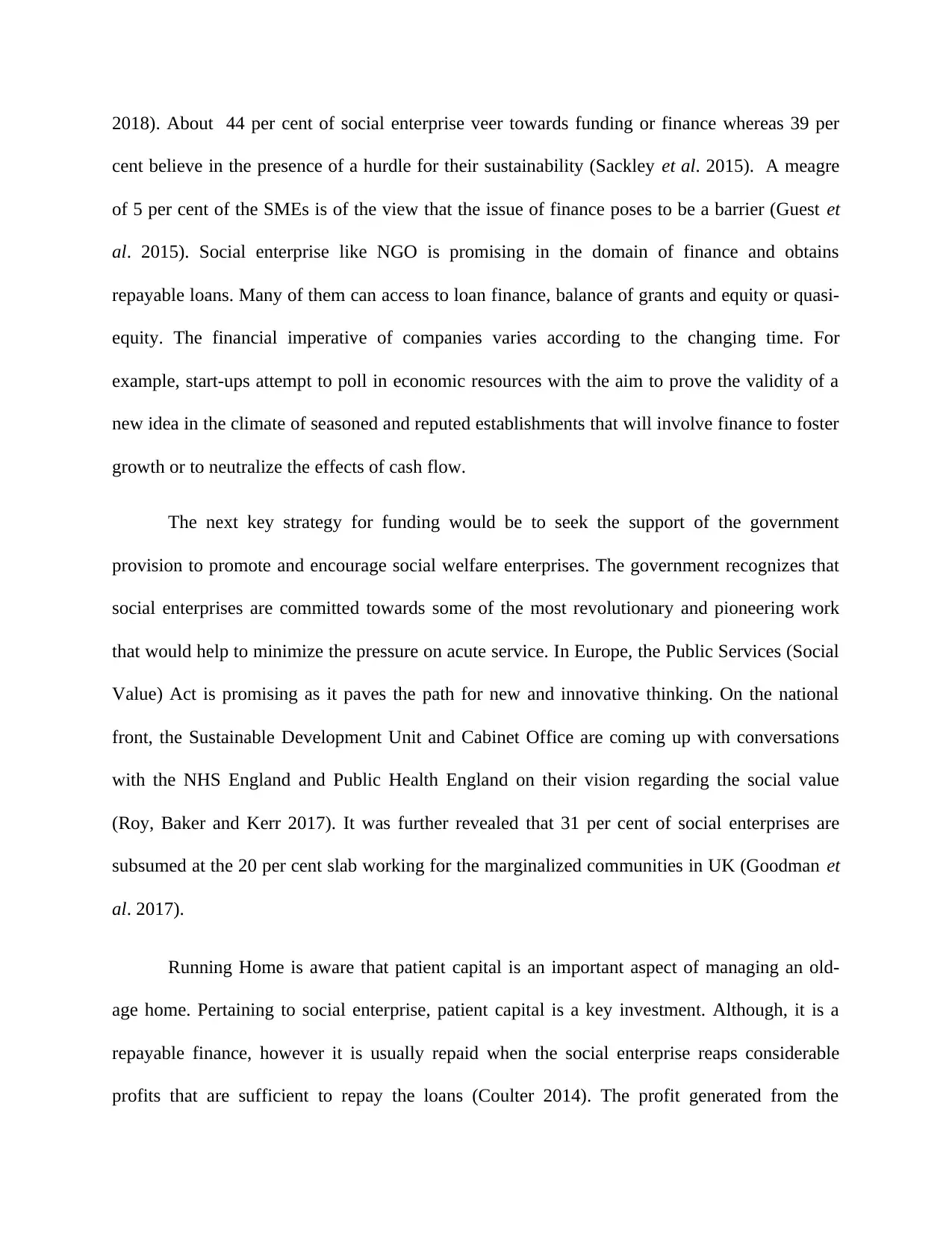
2018). About 44 per cent of social enterprise veer towards funding or finance whereas 39 per
cent believe in the presence of a hurdle for their sustainability (Sackley et al. 2015). A meagre
of 5 per cent of the SMEs is of the view that the issue of finance poses to be a barrier (Guest et
al. 2015). Social enterprise like NGO is promising in the domain of finance and obtains
repayable loans. Many of them can access to loan finance, balance of grants and equity or quasi-
equity. The financial imperative of companies varies according to the changing time. For
example, start-ups attempt to poll in economic resources with the aim to prove the validity of a
new idea in the climate of seasoned and reputed establishments that will involve finance to foster
growth or to neutralize the effects of cash flow.
The next key strategy for funding would be to seek the support of the government
provision to promote and encourage social welfare enterprises. The government recognizes that
social enterprises are committed towards some of the most revolutionary and pioneering work
that would help to minimize the pressure on acute service. In Europe, the Public Services (Social
Value) Act is promising as it paves the path for new and innovative thinking. On the national
front, the Sustainable Development Unit and Cabinet Office are coming up with conversations
with the NHS England and Public Health England on their vision regarding the social value
(Roy, Baker and Kerr 2017). It was further revealed that 31 per cent of social enterprises are
subsumed at the 20 per cent slab working for the marginalized communities in UK (Goodman et
al. 2017).
Running Home is aware that patient capital is an important aspect of managing an old-
age home. Pertaining to social enterprise, patient capital is a key investment. Although, it is a
repayable finance, however it is usually repaid when the social enterprise reaps considerable
profits that are sufficient to repay the loans (Coulter 2014). The profit generated from the
cent believe in the presence of a hurdle for their sustainability (Sackley et al. 2015). A meagre
of 5 per cent of the SMEs is of the view that the issue of finance poses to be a barrier (Guest et
al. 2015). Social enterprise like NGO is promising in the domain of finance and obtains
repayable loans. Many of them can access to loan finance, balance of grants and equity or quasi-
equity. The financial imperative of companies varies according to the changing time. For
example, start-ups attempt to poll in economic resources with the aim to prove the validity of a
new idea in the climate of seasoned and reputed establishments that will involve finance to foster
growth or to neutralize the effects of cash flow.
The next key strategy for funding would be to seek the support of the government
provision to promote and encourage social welfare enterprises. The government recognizes that
social enterprises are committed towards some of the most revolutionary and pioneering work
that would help to minimize the pressure on acute service. In Europe, the Public Services (Social
Value) Act is promising as it paves the path for new and innovative thinking. On the national
front, the Sustainable Development Unit and Cabinet Office are coming up with conversations
with the NHS England and Public Health England on their vision regarding the social value
(Roy, Baker and Kerr 2017). It was further revealed that 31 per cent of social enterprises are
subsumed at the 20 per cent slab working for the marginalized communities in UK (Goodman et
al. 2017).
Running Home is aware that patient capital is an important aspect of managing an old-
age home. Pertaining to social enterprise, patient capital is a key investment. Although, it is a
repayable finance, however it is usually repaid when the social enterprise reaps considerable
profits that are sufficient to repay the loans (Coulter 2014). The profit generated from the
⊘ This is a preview!⊘
Do you want full access?
Subscribe today to unlock all pages.

Trusted by 1+ million students worldwide
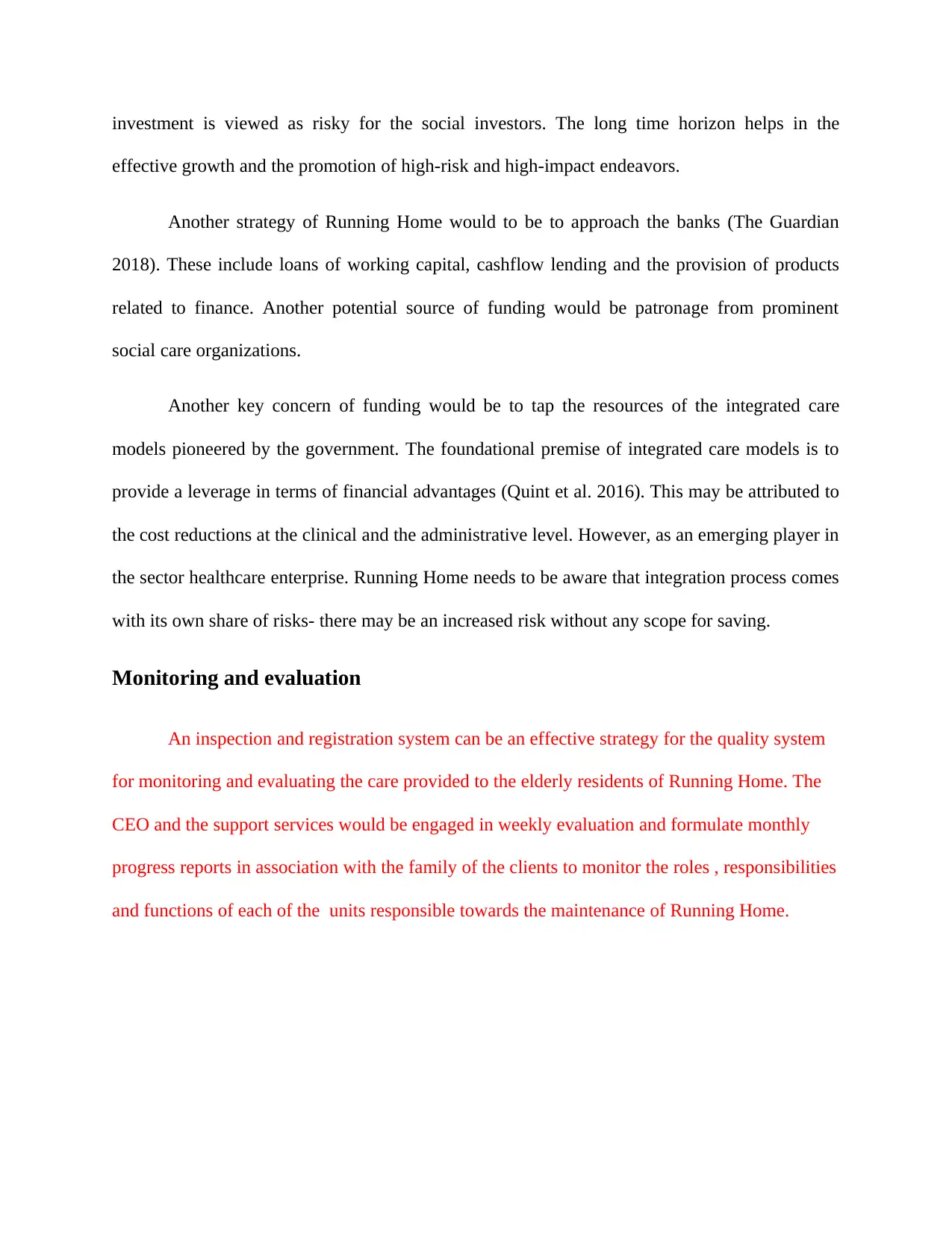
investment is viewed as risky for the social investors. The long time horizon helps in the
effective growth and the promotion of high-risk and high-impact endeavors.
Another strategy of Running Home would to be to approach the banks (The Guardian
2018). These include loans of working capital, cashflow lending and the provision of products
related to finance. Another potential source of funding would be patronage from prominent
social care organizations.
Another key concern of funding would be to tap the resources of the integrated care
models pioneered by the government. The foundational premise of integrated care models is to
provide a leverage in terms of financial advantages (Quint et al. 2016). This may be attributed to
the cost reductions at the clinical and the administrative level. However, as an emerging player in
the sector healthcare enterprise. Running Home needs to be aware that integration process comes
with its own share of risks- there may be an increased risk without any scope for saving.
Monitoring and evaluation
An inspection and registration system can be an effective strategy for the quality system
for monitoring and evaluating the care provided to the elderly residents of Running Home. The
CEO and the support services would be engaged in weekly evaluation and formulate monthly
progress reports in association with the family of the clients to monitor the roles , responsibilities
and functions of each of the units responsible towards the maintenance of Running Home.
effective growth and the promotion of high-risk and high-impact endeavors.
Another strategy of Running Home would to be to approach the banks (The Guardian
2018). These include loans of working capital, cashflow lending and the provision of products
related to finance. Another potential source of funding would be patronage from prominent
social care organizations.
Another key concern of funding would be to tap the resources of the integrated care
models pioneered by the government. The foundational premise of integrated care models is to
provide a leverage in terms of financial advantages (Quint et al. 2016). This may be attributed to
the cost reductions at the clinical and the administrative level. However, as an emerging player in
the sector healthcare enterprise. Running Home needs to be aware that integration process comes
with its own share of risks- there may be an increased risk without any scope for saving.
Monitoring and evaluation
An inspection and registration system can be an effective strategy for the quality system
for monitoring and evaluating the care provided to the elderly residents of Running Home. The
CEO and the support services would be engaged in weekly evaluation and formulate monthly
progress reports in association with the family of the clients to monitor the roles , responsibilities
and functions of each of the units responsible towards the maintenance of Running Home.
Paraphrase This Document
Need a fresh take? Get an instant paraphrase of this document with our AI Paraphraser
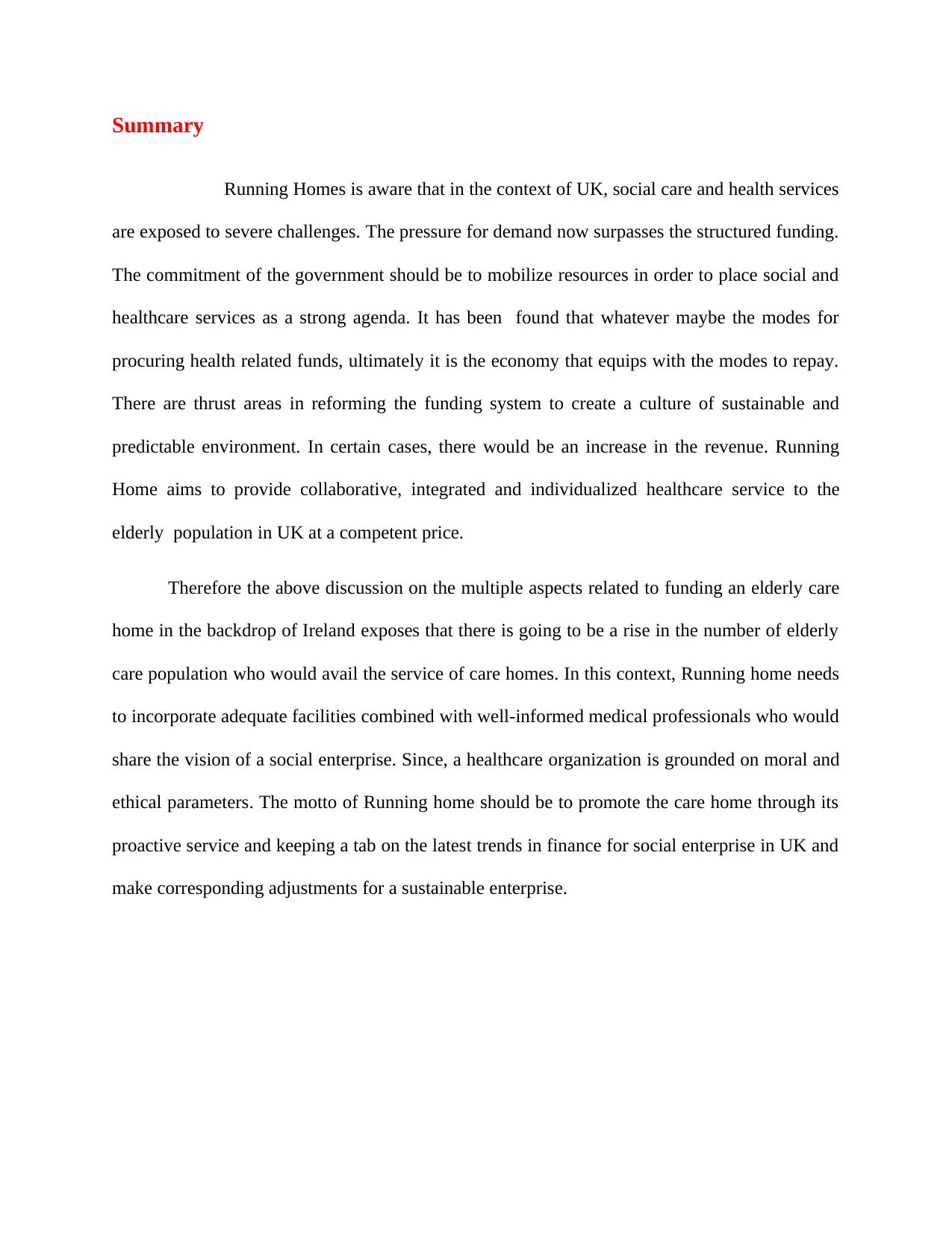
Summary
Running Homes is aware that in the context of UK, social care and health services
are exposed to severe challenges. The pressure for demand now surpasses the structured funding.
The commitment of the government should be to mobilize resources in order to place social and
healthcare services as a strong agenda. It has been found that whatever maybe the modes for
procuring health related funds, ultimately it is the economy that equips with the modes to repay.
There are thrust areas in reforming the funding system to create a culture of sustainable and
predictable environment. In certain cases, there would be an increase in the revenue. Running
Home aims to provide collaborative, integrated and individualized healthcare service to the
elderly population in UK at a competent price.
Therefore the above discussion on the multiple aspects related to funding an elderly care
home in the backdrop of Ireland exposes that there is going to be a rise in the number of elderly
care population who would avail the service of care homes. In this context, Running home needs
to incorporate adequate facilities combined with well-informed medical professionals who would
share the vision of a social enterprise. Since, a healthcare organization is grounded on moral and
ethical parameters. The motto of Running home should be to promote the care home through its
proactive service and keeping a tab on the latest trends in finance for social enterprise in UK and
make corresponding adjustments for a sustainable enterprise.
Running Homes is aware that in the context of UK, social care and health services
are exposed to severe challenges. The pressure for demand now surpasses the structured funding.
The commitment of the government should be to mobilize resources in order to place social and
healthcare services as a strong agenda. It has been found that whatever maybe the modes for
procuring health related funds, ultimately it is the economy that equips with the modes to repay.
There are thrust areas in reforming the funding system to create a culture of sustainable and
predictable environment. In certain cases, there would be an increase in the revenue. Running
Home aims to provide collaborative, integrated and individualized healthcare service to the
elderly population in UK at a competent price.
Therefore the above discussion on the multiple aspects related to funding an elderly care
home in the backdrop of Ireland exposes that there is going to be a rise in the number of elderly
care population who would avail the service of care homes. In this context, Running home needs
to incorporate adequate facilities combined with well-informed medical professionals who would
share the vision of a social enterprise. Since, a healthcare organization is grounded on moral and
ethical parameters. The motto of Running home should be to promote the care home through its
proactive service and keeping a tab on the latest trends in finance for social enterprise in UK and
make corresponding adjustments for a sustainable enterprise.
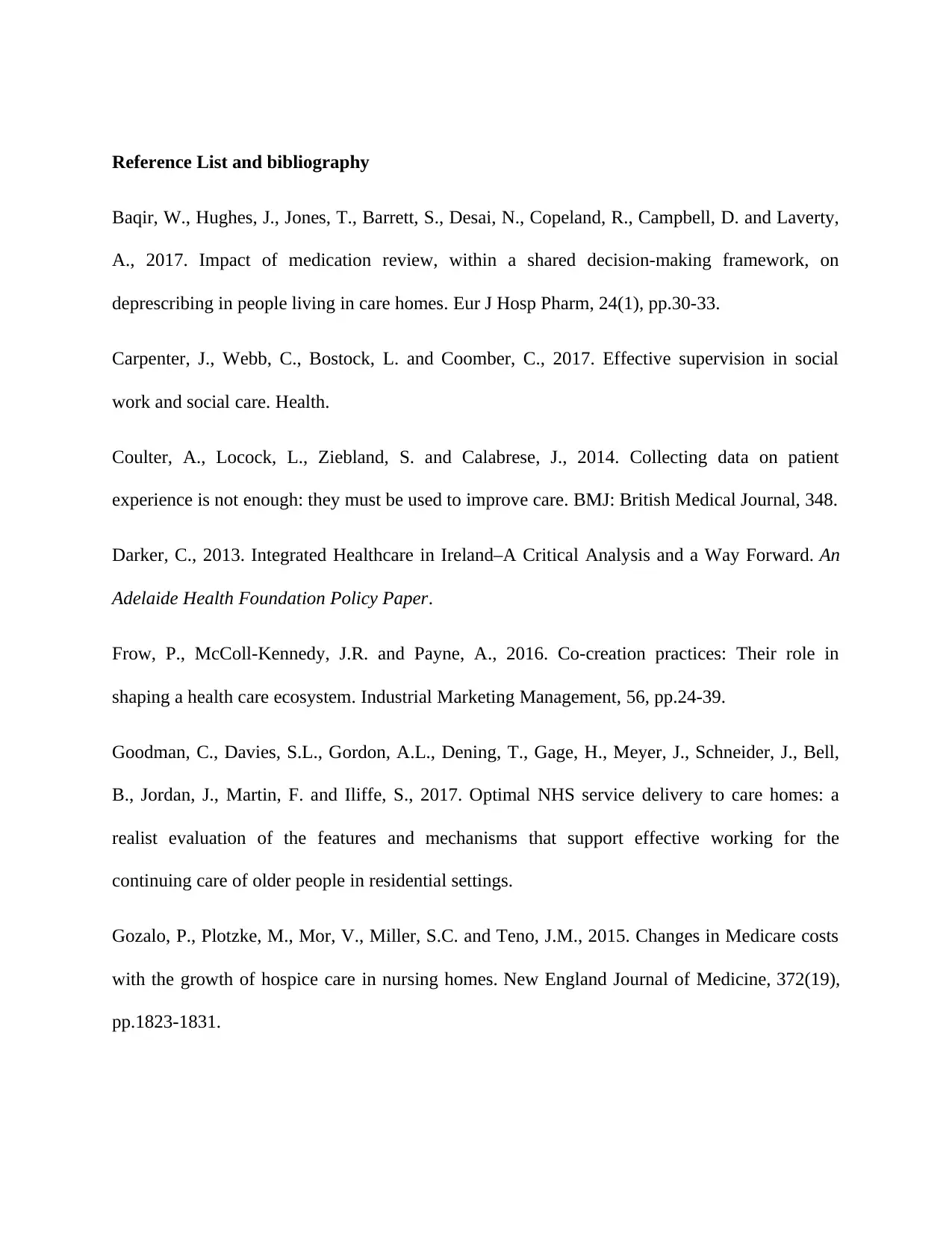
Reference List and bibliography
Baqir, W., Hughes, J., Jones, T., Barrett, S., Desai, N., Copeland, R., Campbell, D. and Laverty,
A., 2017. Impact of medication review, within a shared decision-making framework, on
deprescribing in people living in care homes. Eur J Hosp Pharm, 24(1), pp.30-33.
Carpenter, J., Webb, C., Bostock, L. and Coomber, C., 2017. Effective supervision in social
work and social care. Health.
Coulter, A., Locock, L., Ziebland, S. and Calabrese, J., 2014. Collecting data on patient
experience is not enough: they must be used to improve care. BMJ: British Medical Journal, 348.
Darker, C., 2013. Integrated Healthcare in Ireland–A Critical Analysis and a Way Forward. An
Adelaide Health Foundation Policy Paper.
Frow, P., McColl-Kennedy, J.R. and Payne, A., 2016. Co-creation practices: Their role in
shaping a health care ecosystem. Industrial Marketing Management, 56, pp.24-39.
Goodman, C., Davies, S.L., Gordon, A.L., Dening, T., Gage, H., Meyer, J., Schneider, J., Bell,
B., Jordan, J., Martin, F. and Iliffe, S., 2017. Optimal NHS service delivery to care homes: a
realist evaluation of the features and mechanisms that support effective working for the
continuing care of older people in residential settings.
Gozalo, P., Plotzke, M., Mor, V., Miller, S.C. and Teno, J.M., 2015. Changes in Medicare costs
with the growth of hospice care in nursing homes. New England Journal of Medicine, 372(19),
pp.1823-1831.
Baqir, W., Hughes, J., Jones, T., Barrett, S., Desai, N., Copeland, R., Campbell, D. and Laverty,
A., 2017. Impact of medication review, within a shared decision-making framework, on
deprescribing in people living in care homes. Eur J Hosp Pharm, 24(1), pp.30-33.
Carpenter, J., Webb, C., Bostock, L. and Coomber, C., 2017. Effective supervision in social
work and social care. Health.
Coulter, A., Locock, L., Ziebland, S. and Calabrese, J., 2014. Collecting data on patient
experience is not enough: they must be used to improve care. BMJ: British Medical Journal, 348.
Darker, C., 2013. Integrated Healthcare in Ireland–A Critical Analysis and a Way Forward. An
Adelaide Health Foundation Policy Paper.
Frow, P., McColl-Kennedy, J.R. and Payne, A., 2016. Co-creation practices: Their role in
shaping a health care ecosystem. Industrial Marketing Management, 56, pp.24-39.
Goodman, C., Davies, S.L., Gordon, A.L., Dening, T., Gage, H., Meyer, J., Schneider, J., Bell,
B., Jordan, J., Martin, F. and Iliffe, S., 2017. Optimal NHS service delivery to care homes: a
realist evaluation of the features and mechanisms that support effective working for the
continuing care of older people in residential settings.
Gozalo, P., Plotzke, M., Mor, V., Miller, S.C. and Teno, J.M., 2015. Changes in Medicare costs
with the growth of hospice care in nursing homes. New England Journal of Medicine, 372(19),
pp.1823-1831.
⊘ This is a preview!⊘
Do you want full access?
Subscribe today to unlock all pages.

Trusted by 1+ million students worldwide
1 out of 20
Related Documents
Your All-in-One AI-Powered Toolkit for Academic Success.
+13062052269
info@desklib.com
Available 24*7 on WhatsApp / Email
![[object Object]](/_next/static/media/star-bottom.7253800d.svg)
Unlock your academic potential
Copyright © 2020–2025 A2Z Services. All Rights Reserved. Developed and managed by ZUCOL.



